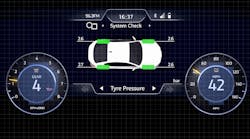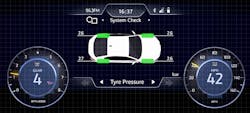From IP to Eye Level: The Layers of an Automotive System
What you’ll learn:
- Why bespoke GPUs designed specifically for automotive use are increasingly important.
- How automakers are developing highly interoperable software and operating systems to bridge the many complex automotive systems in a vehicle.
- How automotive GPUs can be deployed in a functionally safe way to provide data to the driver without failure.
Less than one in four people look at power and performance as their key consideration when purchasing a modern car, compared to over a third for whom the decider is comfort and the in-vehicle user experience. This reality is something that auto manufacturers are rapidly coming to terms with—the new battleground in automotive excellence has crept out from under the bonnet into the cockpit.
Many manufacturers have been in the business for decades, if not centuries. In that time, they’ve become experts at hardware, from drivetrains to chassis and from BHP to RPM. But in modern and future vehicles, hardware isn’t enough without a gorgeous, performant user front end.
Silicon—The New Engine Driving Desirability
Compute has become the cornerstone for automotive vehicles in all facets of their operation. Lots of talk surrounds advanced driving-assistance systems (ADAS) and autonomous driving (AD), but everything—from engine management and emission control to climate and the human machine interface (HMI)—are all powered by general-purpose graphics processing units (GPGPUs).
With this increasing reliance on GPUs, it’s not sufficient to attempt to adapt generic solutions; these often have an impractical space and thermal requirement eating into occupancy space and comfort. With the thunderous march toward electrification, one of their biggest issues is inefficient power requirements that could hugely affect the range of future electric vehicles (EVs).
On top of these more logistical reasons to have automotive-focused GPUs, there’s the issue of functional safety. If a game’s console or a television’s GPU crashes, no one gets hurt. In the autonomous space, though, these issues could be fatal. Industry standards such as ISO 26262 and the numerous ASIL safety levels need to be integrated and certified from the ground up, such as in Imagination Technologies’ BXS series of automotive GPUs.
All for One, and One for All
If a solid GPU is the heart of the system, the operating system is the lifeblood of moving data around the vehicle. The automotive industry has made huge steps in developing a universally adopted operating system. Since 2003, the world’s largest automotive manufacturers have been working on the AUTomotive Open System ARchitecture (AUTOSAR).
By standardizing large chunks of the operating system, manufacturers have done a great job of allowing innovation to flourish. When feature designers don’t need to build from the ground up, this can eliminate the time taken to gain momentum and fight through the headache of interoperability.
It also provides an excellent safety net for developers. They know that with the use of a virtual function bus (VFB), their application or function will be able to mesh seamlessly with the rest of the system even if it uses a unique run-time environment (RTE).
Running multiple RTEs using a VFB allows for a central point of interface, meaning that these systems can communicate with each other. To be able to receive these data inputs, process them, and pass them out across the hundreds of electronic control units (ECUs) in a modern vehicle requires lots of simultaneous compute. On top of that, the VFB will not be the only high-data-flow application that a GPU will need to process. It also may be simultaneously maintaining the HMI operating system (OS) and ensuring that safety-critical graphics functions are being performed.
The best approach to keep this all running safely and smoothly is a multicore GPU. With more cores in a system, more data can be processed concurrently to minimize latency. It also allows for unique ways to segment and process the most important data.
A GPU with multiple cores and flexibility built in from its inception can use hardware virtualization to allow multiple OSs and applications to operate in silos where required on separate cores. This means if a transient error is in another area of the GPU, safety-critical systems remain functional.
OSs like AUTOSAR have helped slash development costs for software systems in a car, but the saving hasn’t gone back into the bottom line. A combined annual growth of 20% a year is predicted between now and 2030 across ADAS and infotainment development, meaning that it’s never been more important to present a vibrant, rich visual environment in the cockpit.
The Cherry on the Cake
Many customers have gone from caring about the inches of the rims to the inches of the screen, but size alone isn’t going to be the differentiator. The rise of 4K displays and high-dynamic-range (HDR) content has been momentous in the last four to five years. It has made its way from premium televisions to the mass market and mobile phones. Consumers also are beginning to expect this level of fidelity in their vehicles.
With all of those extra pixels, the GPU compute requirement will expand exponentially. It won’t just be passive information display either—many of these displays will be touch-enabled interfaces that need to be precise and responsive. Studies have shown as input latency increases, so too does the accuracy of a performed task on the display.
Not only is this an inconvenience that can sour the user’s experience, it also poses a safety risk when distraction and frustration due to input lag can cause focus to be drawn away from the road. Another safety-critical element of a cockpit display is the dials and clusters. Where previously these were expensive, difficult-to-engineer mechanical clusters, they’re now increasingly becoming fully digital. Things like current speed, gear indication, and hazard lights must be rendered correctly, and input delay can’t be tolerated.
To keep everything running smoothly and safely, there are evolving schools of thought involving separate GPUs to power the dials and cluster independently of other systems, or even having hybrid solutions with physical warning lights behind an otherwise digital panel.
These can be restrictive from a design and cost standpoint, requiring more GPUs or limiting the ways the dials can be rendered by the user interface (UI). Another way is with tile region protection (TRP), a technology featured in the BXS GPU. It can segment and mark areas of the screen as safety critical so that they will be given rendering priority no matter the system conditions, and thus maintain up-to-date information.
To perform a second pass of an entire display render can be very costly in terms of frame rate and latency, which is unacceptable. TRP breaks the screen down into a series of tiles and then assigns tiles on the screen as safety critical based on their contents (Fig. 1).
By only requiring certain safety-critical areas of the screen to be self-checked while rendering, the performance impact is negligible. The other advantage of this system is it allows dynamism in what’s displayed in the dials and clusters. With the same data from Figure 1, were the driver to change their display to monitor, for example, tire pressure, TRP would still work (Fig. 2). It would allow the UI to be optimized for ease of use while still identifying and validating safety critical information.
Check out this video for an example of this technology in practice:
Like a Wise Man Who Builds His House on a Rock
The HMI and infotainment systems are the first things that greet the driver when they enter the vehicle and typically the last thing they remember about their experience. Auto manufacturers are making these experiences better every day with the help of automotive-focused, efficient, and performant GPUs at the center of the system.


